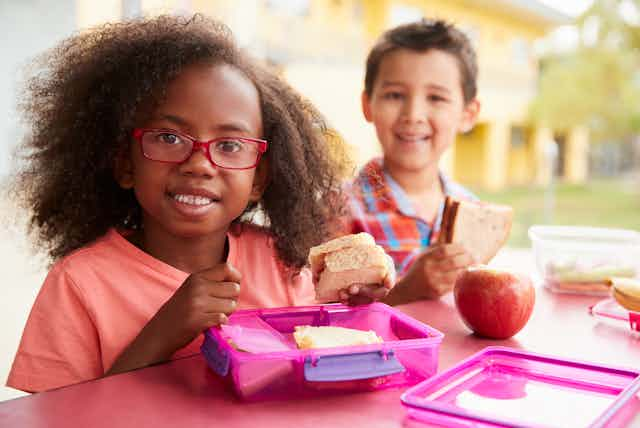Debate over the provision of free school meals in England – which has erupted at several points during the past year – resurfaced once again this week. Parents reported that £30 vouchers, intended for the purchase of school lunches for two weeks, had been replaced with food boxes which appeared to contain far less than £30 worth of food.
Images circulating on social media prompted outcry and a commitment from the government to return to the voucher system.
Although the parcel pictured in the tweet above has some appropriate foods in it, there is a clear lack of variety. The parcel certainly contains nowhere near the dietary recommendations for a child. There is a high proportion of complex carbohydrates, but a real lack of key essential nutrients: protein, fat, vitamins and minerals.
The importance of diet to childrens’ development cannot be overstated. They need optimal nutrition to meet the appropriate weight and growth for their age, the normal development of internal organs and the maturation of the digestive system. A healthy diet is required to maintain their immune system, and for neurological, cognitive and physical development.
Furthermore, a bad diet in childhood can have significant repercussions. Research has shown a link between diets high in saturated fat, processed foods and refined carbohydrates and poor mental health in both children and adolescents.
Another study has identified a link between nutrient deficiency and poor sleep. Adequate sleep is vital in childhood: it affects mental and physical health, which in turn will have an impact on learning, memory, mood and happiness.
Children continue to grow until their late teens, and so have a higher energy and nutrient requirement for their body size in relation to adults. Nutrient requirements change throughout childhood, but children have an increased requirement for protein, vitamins and minerals.
Adolescence is a time of rapid growth and development, and so the demand for most nutrients is high. There is little difference in the nutrient requirements between girls and boys, though calorie – energy – intake requirements are higher for boys.
The right foods
Children and teenagers need to be provided with foods and drinks that can provide adequate energy and nutrients for their increased physical, emotional and cognitive needs. Complex carbohydrates such as potatoes, bread, rice and pasta are a good source of energy. They contain fibre and essential vitamins and minerals required for growth and development.
Children should be encouraged to eat at least five portions of fruit and vegetables a day, with the main focus on vegetables. Fruit and vegetables are a good source of vitamins and minerals, including folate, a B vitamin which is needed to make red and white blood cells in the bone marrow, convert carbohydrates into energy and produce DNA and RNA for growth and development.
Fruit and vegetables also provide vitamin C, which aids in the development of healthy bones and teeth and supports the body’s immune system, and potassium, which is necessary for the normal functioning of all cells. They also help to maintain a healthy gut.
Meat, beans, pulses, fish and eggs are rich sources of protein, vitamins and minerals. It is recommended that children eat two portions of fish a week, one at least being oily fish. Eggs are an excellent source of nutrients and can be incorporated into various meals at any time of the day. Although children often love foods such as sausages, bacon and reformed meat products, these should be limited as they are high in fat and salt.
Milk and dairy foods are a good source of calcium, vitamins A and D, protein and fat, and as such are an important element of a child’s diet. Calcium in particular is needed to help the development of strong bones and for nerve and muscle function, while Vitamin D is required to help absorb calcium, and this should be taken in supplement form throughout the winter months.
Snacks and drinks are also important to consider, and parents should think carefully about what their child is snacking on. Unhealthy snacks include crisps, sweets, french fries and sugary drinks. Examples of healthy snacks are cut up fruit and vegetables, nuts, plain popcorn, yoghurt and cheese.
Changing the food boxes back to vouchers gives parents the ability to choose food for their children. However, easily accessible ready meals and takeaways have meant that many people, throughout society, lack the ability to cook healthy and nutritious meals or know how to use leftovers to produce a meal.
Recipe cards or links to how to cook knowledgeably would be a good addition to the provision of food vouchers, along with information on which foodstuffs should be kept as basics in order to cook meals from scratch.
It is imperative that more is done to help people know how and what to cook. Developing healthy eating habits and an interest in food from an early age can help promote a lifelong enjoyment of healthy and nutritious food.

